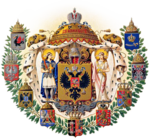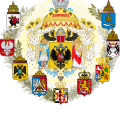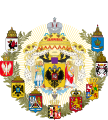File:Middle Coat of Arms of the Russian Empire.svg

Original file (SVG file, nominally 512 × 487 pixels, file size: 15.12 MB)
| This is a file from the Wikimedia Commons. Information from its description page there is shown below. Commons is a freely licensed media file repository. You can help. |
Summary
This representation of a coat of arms is potentially different from the one used by the armiger (municipality or organisation) in question.
| |
|---|---|
⇑ “Sable, a lion
rampant or” |
This coat of arms was drawn based on its blazon which – being a written description – is free from copyright. Any illustration conforming with the blazon of the arms is considered to be heraldically correct. Thus several different artistic interpretations of the same coat of arms can exist. Sometimes, the design officially used by the armiger is likely protected by copyright, in which case it cannot be used here.
Individual representations of a coat of arms, drawn from a blazon, may have a copyright belonging to the artist, but are not necessarily derivative works. Further information: Commons:Coats of arms and Template:Coa blazon беларуская (тарашкевіца) ∙ català ∙ Deutsch ∙ English ∙ español ∙ suomi ∙ français ∙ italiano ∙ 日本語 ∙ Lëtzebuergesch ∙ македонски ∙ Nederlands ∙ русский ∙ svenska ∙ ไทย ∙ українська ∙ 中文 ∙ 中文(简体) ∙ 中文(繁體) ∙ +/− |
| DescriptionMiddle Coat of Arms of the Russian Empire.svg |
English: Or, a double-headed Imperial Eagle displayed Sable, twice imperially crowned proper, armed and membered Gold, langued Gules, grasping in the dexter claw an imperial sceptre, and in the sinister claw an imperial orb, all proper; in chief another bigger imperial crown with issuant and pendent therefrom a blue-celeste ribbon of the Order of St. Andrew the First-Called; the Imperial Eagle is charged on the breast with an escutcheon: Gules, an image of St. George Martyr the Victorious in complete armour Argent, wearing a flying cloak Azure, riding a horse in full gallop Argent, the latter is covered with a horse-cloth Gules, fringed, bridled and maned Or, and treading upon a dragon crawling in base Or, winged Vert, whose head the rider is piercing through with a spear, the rear end of the latter is terminating in an Orthodox cross Gold (for Moscow); above the shield is placed a helmet of St. Prince Alexander of Neva, with a mantling Sable, doubled Or; the shield is encircled with the collar and pendent therefrom a badge of the Order of St. Andrew the First-Called; and for supporters are: on the dexter side St. Michael the Taxiarch in complete armour, holding in the dexter hand a sword enflamed, all proper; and on the sinister side St. Gabriel the Archangel habited proper, holding in the sinister hand a long cross Gold; all displayed within an imperial robe of estate with a pavilion Or, semée of imperial eagles, doubled Ermine, and ensigned with an imperial crown proper; along the pavilion’s rim is a motto: “СЪ НАМИ БОГЪ” which means “GOD WITH US”, lettered Gules; the imperial robe of estate is semi circled below by nine shields, each being ensigned with its proper crown: first Argent, a wyvern Sable, crowned and armed Or, winged, langued and tailed Gules (for the Kingdom of Kazan); second Azure, a royal crown of eight arches (five visible) Or, doubled Vert, above a sabre curved in fess point to the dexter Argent, hilted and pummeled Or (for the Kingdom of Astrakhan); third Gules, an eagle displayed Argent, royally crowned proper, armed and membered Or (for the Kingdom of Poland); fourth Ermine, two sables rampant combatant Sable, supporting an ancient crown Or, and a bow in fess, with two arrows saltirewise points downwards, all Gules (for the Kingdom of Siberia); fifth Or, a double-headed Byzantine eagle displayed Sable, twice royally crowned and armed Gold, charged on the breast with an escutcheon: Azure, an Orthodox cross within a bordure, all Or (for the Kingdom of the Chersonesus Taurica); sixth quarterly with enté en pointe and an inescutcheon (for the Kingdom of Georgia): first Gules, between in sinister chief and dexter base two mullets of eight points, a horse in full gallop all Argent (for Iberia); second Or, a volcano fumant Vert, pierced through with two arrows saltirewise points upwards Sable (for Kartli); third Azure, between in chief and at either side three mullets of six points Argent, two arrows saltirewise points upwards of the same, debruised by an inescutcheon Or, charged with an increscent Gules (for Kabardia); fourth Or, a lion rampant Gules, crowned proper (for Armenia); fifth Enté en pointe Or, a Chercassian warrior in complete armour Argent, habited Gules and wearing a fur cloak Sable, holding a spear of the same on the dexter shoulder, and riding a horse in full gallop Sable (for the Chercassian and Mountaineer Princes); the inescutcheon: Or, an image of St. George Martyr the Victorious in complete armour Azure with a cross on the breast, wearing a flying cloak Gules, and riding a horse in full gallop Sable, covered with a horse-cloth Gules, fringed Gold, treading upon a crawling dragon Vert, winged Sable, eyed and langued Gules, whose head the rider is piercing through with a spear Gules (for Georgia); seventh tierced per pale and enté en pointe: first Azure, an image of St. Michael the Archangel in complete armour with the wings inverted all Argent, holding in the dexter hand a sword enflamed proper, and in the sinister hand a shield Argent (for the Grand Duchy of Kiev); second Gules, a lion rampant guardant Or, crowned with an iron crown proper, holding in the dexter forepaw a long cross Argent (for the Grand Duchy of Vladimir); third Enté en pointe Argent, two bears statant erect combatant Sable, supporting a throne Or, cushioned Gules, on which are placed a sceptre and a long cross saltirewise, both Or; on the back of the Throne is a triple candlestick Gold with three lighted candles proper; in a base Azure, two fish fesswise respectant naiant and counter-naiant Argent (for the Grand Duchy of Novgorod); eighth Gules, between eight roses Argent, barbed and seeded proper, a lion rampant Or, ducally crowned proper, holding in the dexter vambraced forepaw a straight-bladed sword proper, hilted and pommeled Or, and resting the sinister forepaw on a curved sabre proper, hilted and pommeled as the latter, the blade of which the lion is treading upon with the dexter hind paw (for the Grand Duchy of Finland); beneath all is placed a shield, ensigned with a royal crown proper, displaying the Ancestral Arms of His Imperial Majesty: per pale, first Argent, a griffin segreant Gules, holding a sword proper and a round shield Or, ensigned upon its upper edge with an eaglet Sable, all within a bordure Sable, charged with eight lion’s heads erased Or and Argent alternately (for the House of Romanov); second quarterly with enté en pointe and an inescutcheon, first Gules, a lion rampant Or, crowned proper, holding in the forepaws a long-handled axe of St. Olaf Argent, handled Or (for Norway); second Or, two lions passant Azure (for Schleswig); third Gules, an inescutcheon per fess Argent and Gules, between three nettle leaves and as many passion nails in pairle Argent (for Holstein); fourth Gules, a swan Argent, beaked, membered and royally gorged Or (for Stormarn); fifth Enté en pointe: Gules, a knight in armour Or, on a horse Argent, brandishing a sword Argent, and with a shield Azure, charged with a cross pattée Or (for Ditmarsen); over all, an inescutcheon of pretence ensigned with a Duke’s crown proper, namely: Per pale, first Or, two bars Gules (for Oldenburg); second Azure, a cross pattée fitchy Or (for Delmenhorst).
Русский: В золотом щите чёрный двоеглавый орёл, коронованный двумя Императорскими коронами, над которыми третия такая ж, в большем виде, корона с двумя развевающимися концами ленты ордена Святого Апостола Андрея Первозванного; государственный орёл держит золотые скипетр и державу; на груди орла герб Московский: в червлёном с золотыми краями щите Святый Великомученик и Победоносец Георгий в серебряном вооружении и лазуревой приволоке (мантии), на серебряном, покрытом багряною тканью с золотою бахромою, коне, поражающий золотого, с зелёными крылиями, дракона, золотым, с восьмиконечным крестом на верху, копиём; главный щит (с гербом Государственным) увенчан шлемом Святого Великого Князя Александра Невского; намёт чёрный с золотом; вокруг щита цепь ордена Святого Апостола Андрея Первозванного; по сторонам изображения Святых Архистратига Михаила и Архангела Гавриила; сень золотая, коронованная Императорскою короною, усеянная Российскими двоеглавыми орлами и подложена горностаем; на ней червлёная надпись: «СЪ НАМИ БОГЪ!»; вокруг главного щита, щиты с гербами Царств и нижеозначенных Великих Княжеств: в первом серебряном щите герб Царства Казанского: чёрный коронованный дракон; язык, крылья и хвост червлёные, клюв и когти золотые; во втором лазуревом щите герб Царства Астраханского: золотая, подобная Королевской, корона, с пятью дугами и зелёною подкладкою; под нею серебряный восточный меч, с золотою рукоятью, острым концом вправо; в третьем червлёном щите герб Царства Польского: серебряный коронованный орёл, с золотыми клювом и когтями; в четвёртом горностаевом щите герб Царства Сибирского: два чёрные соболя, стоящие на задних лапах и поддерживающие передними, одной золотую пятизубцовую корону, другою червлёный лежащий лук и две крестообразно, остриями вниз, поставленные стрелы; в пятом золотом щите герб Царства Херсониса Таврического: чёрный византийский, увенчанный двумя золотыми коронами, орёл, с червлёными языками и золотыми клювами и когтями; на груди, в лазуревом, с золотыми краями, щите, золотой осьмиконечный крест; в шестом четверочастном щите с оконечностью и малым в средине щитом герб Царства Грузинского: в среднем малом щите герб Грузии: в золотом поле Святый Великомученик и Победоносец Георгий, в лазуревом вооружении, с золотым на груди крестом, в червлёной приволоке, сидящий на чёрном коне, покрытом багряницею с золотою бахрамою, поражающий червлёным копиём зелёного, с чёрными крылиями и червлёнными и глазами и языком, дракона; в первой червлёной части герб Иверии: серебряный скачущий конь; в углах, верхнем левом и нижнем правом, серебряные звёзды о восьми лучах; во второй золотой части герб Карталинии: зелёная огнедышущая гора, пронзённая крестообразно двумя чёрными стрелами, остриями вверх; в третией лазуревой части герб Кабардинския земли: на двух серебряных, крестообразно, остриями вверх, положенных стрелах, малый золотой щит с червлёным обращённым вправо полумесяцем; в трёх первых четвертях серебряные шестиугольные звёзды; в четвёртой золотой части герб Армении: червлёный коронованный лев; в золотой оконечности герб Черкасских и Горских Князей: скачущий на чёрном коне черкес, в серебряном вооружении, червлёной одежде и чёрной из меха приволоке, с чёрным копиём на правом плече; в седьмом, разделенном вилообразно на три части, щите соединенные гербы Великих Княжеств Киевского, Владимирского и Новогородского: в первой лазуревой части герб Киевский: Святый Архистратиг Михаил в серебряном одеянии и вооружении, с пламенеющим мечём и серебряным щитом; во второй червлёной части герб Владимирский: золотой львиный леопард, в железной, украшенной золотом и цветными камнями, короне, держащий в правой лапе длинный серебряный крест; в третией серебряной части герб Новогородский: два чёрные медведя, поддерживающие кресла золотые с червлёною подушкою, на коей поставлены, крестообразно, с правой стороны скипетр, а с левой крест; над креслами золотой трисвещник с горящими свечами; в лазуревой окраине щита две серебряные, одна против другой, рыбы; в восьмом червлёном щите герб Великого Княжества Финляндского: золотой коронованный лев, держащий в правой лапе меч прямой, а в левой меч выгнутый, на который опирается заднею правою лапою лев, сопровождаемый восемью серебряными розами; все сии щиты увенчаны принадлежащими им коронами; внизу главного щита (с гербом Государственным) родовой Его Императорского Величества герб: щит рассеченный; в право герб рода Романовых: в серебряном поле червлёный гриф, держащий золотые меч и тарч, увенчанный малым орлом; на чёрной кайме, восемь оторванных львиных голов, четыре золотые и четыре серебряные; в лево герб Шлезвиг-Голстинский: щит четверочастный с особою внизу оконечностию и малым на середине щитом; в первой червлёной части герб Норвежский: золотой коронованный лев с серебряною галлебардою; во второй золотой части герб Шлезвигский: два лазуревые леопардные льва; в третьей червлёной части герб Голстинский: пересечённый малый щит, серебряный и червленый; вокруг оного серебряный, разрезанный на три части, лист крапивы и три серебряные гвоздя с концами к углам щита; в четвёртой червлёной части герб Стормарнский: серебряный лебедь с чёрными лапами и золотою на шее короною; в червлёной оконечности герб Дитмарсенский: золотой, с подъятым мечом, всадник на серебряном коне, покрытом чёрною тканию; средний малый щит также рассечённый: в правой половине герб Ольденбургский: на золотом поле два червлёные пояса; в левой герб Дельменгорстский: в лазуревом поле золотой, с острым внизу концом, крест; сей малый щит увенчан Велико-Герцогскою короною, а главный Королевскою. |
|||
| Date | ||||
| Source |

|
|||
| Author | B. V. Kyone | |||
| Permission (Reusing this file) |
|
Licensing
| Public domainPublic domainfalsefalse |
This work was published on territory of the Russian Empire (Russian Republic) except for territories of the Grand Duchy of Finland and Congress Poland before 7 November 1917 and wasn't re-published for 30 days following initial publications on the territory of Soviet Russia or any other countries.
The Russian Federation (early Soviet Russia, RSFSR) is the historical heir but not legal successor of the Russian Empire, and the Russian Empire was not party to the Berne Convention (it was not country of Union for the protection of the rights of authors in their literary and artistic works), so according to article 5 of the Convention this work has no country of origin except:
¹ - Author who is not a national of a country of the Union but who has his habitual residence in a country of the Union, be assimilated to national of that country. The exclusive rights to this work do not extend on territory of the Russian Federation according to article 1256 of the Civil Code of the Russian Federation (details), because this work does not meet the requirements on the territory of publication, on the author's nationality, and on obligations for international treaties. If applicable, {{PD-Russia-expired}} should be used instead of this tag. This work is in the public domain in the United States because it was published (or registered with the U.S. Copyright Office) before January 1, 1929. |
Captions
Items portrayed in this file
depicts
File history
Click on a date/time to view the file as it appeared at that time.
| Date/Time | Thumbnail | Dimensions | User | Comment | |
|---|---|---|---|---|---|
| current | 19:34, 28 June 2023 |  | 512 × 487 (15.12 MB) | Great Brightstar | Fix missing arms based on elements from File:COA of Tsardom of Georgian.svg |
| 19:07, 28 June 2023 |  | 512 × 487 (15.11 MB) | Great Brightstar | Fix regression | |
| 18:58, 28 June 2023 |  | 512 × 487 (15.1 MB) | Great Brightstar | Fix helmet, replace Polish coat of arms | |
| 07:28, 14 May 2023 |  | 512 × 569 (13.33 MB) | Mupper-san | Uploaded a work by B. V. Kyone from {{extracted from|Middle Coat of Arms of the Russian Empire.png}} {{extracted from|Greater Coat of Arms of the Russian Empire.svg}} with UploadWizard |
File usage
The following page uses this file:
Global file usage
The following other wikis use this file:
- Usage on es.wikipedia.org
- Usage on sk.wikipedia.org
- Usage on tr.wikipedia.org
Metadata
This file contains additional information, probably added from the digital camera or scanner used to create or digitize it.
If the file has been modified from its original state, some details may not fully reflect the modified file.
| Width | 100% |
|---|---|
| Height | 100% |



